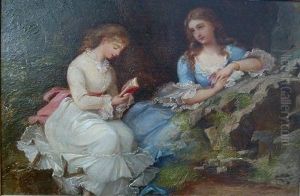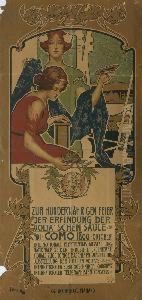Adolf, Adolpho Hohenstein Paintings
Adolfo Hohenstein, born in Saint Petersburg, Russia, in 1854, was a multifaceted artist of German origins who is often celebrated as the father of the Italian poster art movement and a pivotal figure in the development of stage design and graphic design in Italy during the late 19th and early 20th centuries. His family moved to Vienna when he was a child, where he initially received his education and training. Later, he pursued his artistic studies at the Academy of Fine Arts in Vienna. Hohenstein's career took a significant turn when he moved to Italy, a country that became his adopted home and the center of his professional activities.
In Italy, Hohenstein's talents flourished at Ricordi, a prominent publishing company known for its connections with the music and opera world. He was appointed as the head of the graphic design department in 1889, a position that allowed him to exert substantial influence on the visual arts scene in Italy. His work for Ricordi included creating posters, advertising, magazine covers, and stage designs, notably for the premieres of Giacomo Puccini's operas such as 'Tosca' and 'La Bohème', which remain iconic to this day. His style, characterized by its dynamic compositions, vibrant colors, and elegant figures, bridged the gap between the Art Nouveau movement and traditional Italian art, contributing to the development of the so-called Stile Liberty, the Italian variant of Art Nouveau.
Beyond his contributions to graphic design and posters, Hohenstein also made significant strides in stage design, bringing a new level of creativity and innovation to theater productions. His designs were marked by their elaborate detail, historical accuracy, and ability to convey mood and atmosphere, enhancing the theatrical experience for audiences and influencing the direction of stage design in Italy.
Adolfo Hohenstein's legacy is one of artistic innovation and influence. His work not only defined the visual culture of his time but also laid the groundwork for future generations of artists in the fields of graphic design, poster art, and stage design. He died in Bonn, Germany, in 1928, but his work continues to be celebrated for its impact on the visual arts and its role in shaping the aesthetic of an era.

